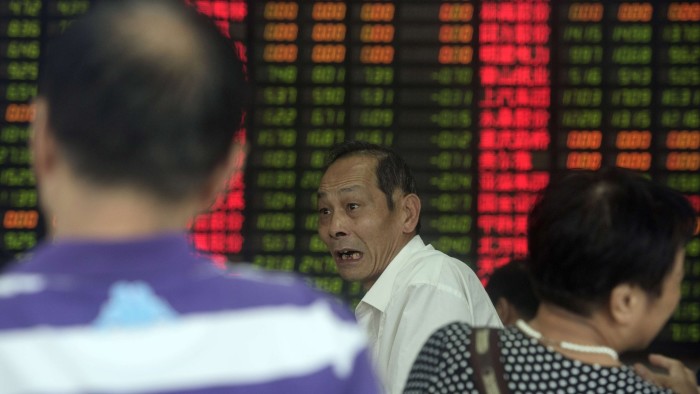Exotic markets bring risks for savers

Simply sign up to the Currencies myFT Digest -- delivered directly to your inbox.
Accessing global markets has never been easier for retail investors who, in a period of historically low yields, often look further afield for higher returns on their money.
Not only do fund managers offer products promising exposure to emerging and frontier markets — the most exotic investment destinations — but many retail investors now hold direct stakes in individual companies listed on far-flung stock exchanges.
But does the convenience of trading in far-flung markets conceal the risks that are facing investors? The recent collapse in the Chinese stock market, which had driven global markets downwards, illustrates the sharp losses that can be wrought on distant investors.
For those whose retirement savings are heavily invested in global equities, the events in August highlighted in particular the vulnerability of their wealth to global events.
“It is very fashionable for financial advisers to talk up emerging markets,” says Jason Hollands, managing director of UK broker Tilney Bestinvest. “They trot out the story of higher long-term [economic] growth rates and better demographics, which is correct, but investors can end up with higher exposure to risky assets than they should.”
Having been widely heralded as a one-way bet, confidence in sustained Chinese economic growth wavered and trillions were wiped off the country’s stock markets. In the three months to the end of August, the Shanghai Composite index lost roughly a third of its value.
Beyond China, investors in developing markets have had a disappointing, and costly, year. In the 12 months to the end of July, the MSCI Emerging Markets index fell 13.4 per cent, compared with gross returns of 5.5 per cent from MSCI’s World index, which includes developed markets. The MSCI Frontier Markets index fell 17.5 per cent in this period.
Not only does performance in less developed markets tend to be more volatile, but liquidity tends to be lower, warns Adrian Lowcock, head of investing at Axa Wealth, part of the French financial services group.
He says: “In developed markets, liquidity is not generally a concern, but in emerging markets it can quickly become an issue, where there is nobody on the ‘buy’ side and the price [of stocks] is driven down rapidly.” Capital outflows in these circumstances can quickly undermine perceptions of liquidity.
Investing via funds, rather than in individual stocks, is an inherently lower risk approach towards overseas markets, says Mick Gilligan, head of fund research at Killik & Co, the wealth management company.
Not only do investors gain instant diversification, he says, but fund managers are often well-placed to judge levels of corporate governance and regulation, which may not be as high or as transparent as in developed western markets.
Fund investments can also minimise currency risks if they are hedged, but there is always a danger that strong investment returns in overseas markets will be offset by the relative strengthening of an investor’s home currency, Mr Hollands points out.
Monetary policies such as aggressive quantitative easing — as seen in Japan, for example — can also weaken currencies, reducing the real value of returns, he adds.
One means of offsetting currency and investment risk is to construct an international portfolio that is diversified, notes Mr Hollands. “You want to avoid over-concentration in any market, including your home market.”
Laith Khalaf, a senior analyst at UK broker Hargreaves Lansdown, warns that investors should not equate investing in a given stock market with direct exposure to that country’s economy.
He gives the example of the FTSE 100, the UK’s prominent index of large listed companies, which derives some two-thirds of its earnings from outside the UK. “It is often not as straightforward as saying, ‘I’m investing in the UK, or Europe’.”
Meanwhile, passive products, such as global index tracker funds, may not deliver the level of diversification investors may be seeking, warns Mr Hollands.
“Because they are based on market [capitalisation], many passive global equity funds will have 50 per cent exposure to the US stock market. This has been great recently in terms of returns, but if you are looking for diversification, do you really want to be so skewed towards the US, which is trading well above average [valuation] trends?”
When valuations rise, it is important that internationally oriented investors rebalance their portfolios to avoid disproportionate exposure to markets that have had a good run, Mr Hollands adds. “Take your profits from growth and reinvest them in better value markets.”
Investors should be mindful, however, of the tax they may have to pay on any dividends or profits. So-called “withholding” tax deductions are made in countries including the US, which levies a 30 per cent charge on payments to foreign investors. (They can avoid double taxation by completing a W-8 BEN form.)
Anyone with their sights on exploring international opportunities should, however, be wary of prospects that sound too promising, warns Mr Lowcock. Advertised returns may not be realised, which would leave investors out of pocket and with little they could do to get their money back.
Regular threats also come in the form of sophisticated investment scams, which often purport to be directed from trusted sources, and which tend to disproportionately target those in retirement.
Those issued by email may simply be attempts at “phishing” — acquiring valuable information such as personal financial details. The prevalence of scams relating to overseas investments underlines the importance of going through a reputable broker, says Mr Lowcock.
“You should always ask: ‘Why have I been approached?’. If there is no good reason, these tend to be the investment opportunities that are not going to deliver,” he says.
Comments